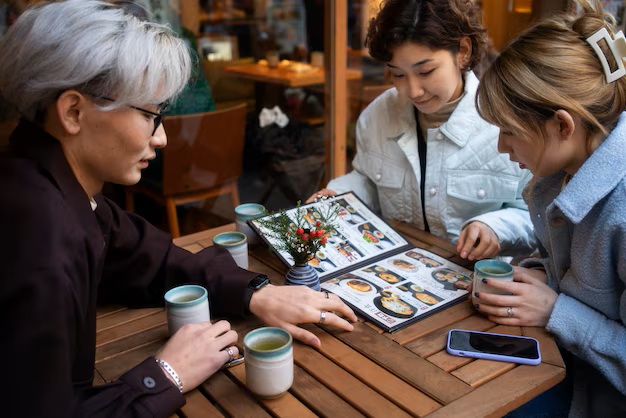In recent years, a remarkable transformation has occurred within culinary realms, blending gastronomic experiences with advanced technologies. This phenomenon has intrigued both entrepreneurs and consumers, opening new avenues for engagement and investment. As dining enthusiasts embrace novel concepts, unique digital creations are reshaping how people interact with culinary delights.
Motivated by the charm of digital collectibles, enthusiasts are discovering dynamic ways to merge gastronomy with engaging online environments. This fusion not only captivates food lovers but also introduces a fresh perspective on ownership and appreciation. The resulting synergy encourages creative collaborations among chefs, brands, and digital creators, forging unprecedented pathways for culinary expression.
A fresh wave of innovations is sprouting, urging stakeholders to reconsider traditional models while adopting a forward-thinking mindset. This evolution marks a pivotal moment where gastronomy intersects with technology, igniting curiosity and fostering a sense of community among participants. The implications of these developments extend beyond mere digital assets; they inspire culinary artistry and elevate consumer experiences.
Understanding NFT Adoption in Food Sector
Recent technological advancements have prompted various sectors to embrace innovative solutions, leading to unique shifts in operations and consumer interactions. This trend is particularly evident in culinary arts, where digital ownership and authentication tools are gaining attention. These developments not only reshape how businesses connect with consumers but also enhance brand loyalty and create new revenue streams.
Motivations Behind Embracing Digital Assets
Organizations in this area are increasingly drawn to virtual collectibles for several reasons. They offer a novel way to engage customers, allowing for memorable experiences. Additionally, these assets can protect intellectual property by certifying authenticity, thus combating issues like counterfeiting. By incorporating blockchain technology, restaurants and producers can maintain a transparent and traceable supply chain.
Challenges to Overcome for Wider Acceptance
Despite growing interest, obstacles still exist. Many stakeholders lack knowledge regarding functionality and potential benefits, which creates hesitation in adoption. Moreover, regulatory frameworks are still evolving, posing further uncertainties. To achieve broader acceptance, education, and collaboration across sectors are essential, ensuring everyone understands the advantages and implications of these cutting-edge assets.
How Grabbing Slice Pie Works
This innovative concept revolves around creating unique digital assets that represent ownership in culinary creations. By utilizing blockchain technology, participants can engage in a novel way to connect with their favorite delicacies, redefining traditional consumption models within this sector.
The mechanics behind this approach can be broken down into several key components:
- Tokenization: Culinary items are transformed into digital tokens, allowing consumers to own a fragment of a specific dish or drink.
- Blockchain Recording: Each transaction is securely recorded on a decentralized ledger, ensuring transparency and authenticity of ownership.
- Marketplace: Participants can buy, sell, or trade their digital tokens in a dedicated online platform, fostering a community of food enthusiasts.
- Rewards System: Owners of these tokens may receive perks, such as exclusive tastings, discounts, or access to limited-edition items.
This system not only enhances customer engagement but also encourages collaboration between culinary creators and their audience, creating a vibrant ecosystem where both can thrive.
Benefits of NFTs for Food Brands
Utilizing digital ownership tokens opens up innovative avenues for culinary enterprises, enhancing customer engagement and creating novel revenue streams. These tokens serve as unique digital assets that can transform how brands interact with consumers and foster loyalty.
Unique Customer Experiences
By offering limited edition digital items, brands can provide exclusive experiences for their patrons. Unique collectibles can be tied to meals or events, allowing customers to own a piece of their favorite culinary moments. This exclusivity can enhance brand loyalty and increase emotional connections to products.
New Revenue Streams
Integrating digital assets into marketing strategies enables culinary businesses to diversify their income sources. Monetizing digital collectibles creates additional financial opportunities while capturing the interest of tech-savvy consumers. These initiatives not only boost sales but also encourage innovative collaborations within the sector.
Consumer Engagement Through Digital Collectibles
In today’s digital landscape, innovative items are transforming connections between brands and consumers. Unique assets are utilized to foster loyalty and create immersive experiences. Engaging customers through collectible formats enhances interaction and propels brand visibility.
Building Loyalty Through Unique Offerings
Savvy brands recognize the potential of digital assets as tools for building lasting relationships. By offering exclusive products, companies can:
- Encourage customer retention through rarity and uniqueness.
- Foster a sense of community among users who share similar interests.
- Create excitement through limited-time releases that drive urgency.
Enhancing Customer Experience
Digital collectibles can redefine customer journeys and unlock new layers of interaction. Some advantages include:
- Access to special promotions, events, or exclusive content.
- The ability to showcase digital assets, enhancing personal brand identity.
- Creating opportunities for users to trade or showcase their collections, fostering engagement.
This modern approach not only influences how consumers interact with brands, but it also paves the way for innovative marketing strategies that resonate with target audiences. By harnessing the power of digital collectibles, companies can effectively capture attention and stimulate ongoing interest.
Challenges Facing NFT Implementation
Numerous obstacles hinder the adoption of digital assets in various sectors. While many companies see potential in utilizing these innovative technologies, several factors complicate their integration into regular business practices.
- Technical Complexity: Understanding blockchain technology requires specialized knowledge. Many businesses lack the technical skills necessary for seamless implementation.
- Regulatory Uncertainty: Existing regulations surrounding digital assets are often ambiguous. This unpredictability can deter companies from committing to these technologies.
- Market Volatility: Fluctuating values of digital assets may pose risks for organizations. Companies may hesitate to invest in ventures that could quickly lose value.
- Consumer Awareness: Many potential users lack knowledge about digital assets and their uses. Educating consumers is crucial for broad acceptance.
- Environmental Concerns: The energy consumption associated with some blockchain technologies raises sustainability questions. Companies must address these issues to maintain a positive image.
- Integration with Traditional Systems: Merging new technologies with existing business models can be challenging. Industries must find ways to bridge the gap between conventional and digital frameworks.
Overcoming these challenges will be essential for companies aiming to harness the advantages of modern digital innovations.
The Future of Food Industry Innovation
In an era marked by rapid transformation, advancements in technology are reshaping various sectors, including culinary enterprises. Innovative practices are emerging, driven by creativity and necessity, fostering new experiences for consumers and businesses alike.
As digital platforms evolve, they provide unique opportunities for interaction between brands and patrons. This dynamic encourages experimentation and allows for the integration of fresh concepts, enhancing engagement and loyalty. These developments not only affect product offerings but also influence how culinary establishments operate and connect with their audiences.
| Innovation Type | Description | Potential Benefits |
|---|---|---|
| Technological Integration | Utilizing apps and platforms for seamless ordering and delivery. | Improved efficiency and customer satisfaction. |
| Blockchain Solutions | Implementing transparent supply chain tracking to ensure quality. | Enhanced trust and accountability. |
| Personalization | Customized recommendations based on consumer behavior. | Increased customer retention and higher sales. |
| Sustainability Initiatives | Adopting eco-friendly practices and local sourcing. | Attraction of ethically-conscious clientele. |
As new trends emerge, culinary ventures must adapt, allowing for a thriving ecosystem where innovation flourishes. By embracing these shifts, businesses can unlock unprecedented potential, catering to a diverse range of palates and preferences.
Q&A: Grabbing slice pie nfts food beverage industry
What are Grabbing Slice Pie NFTs and how do they function within the food and beverage industry?
Grabbing Slice Pie NFTs are unique digital assets that represent ownership of a portion of a virtual or real food product, often associated with a specific brand or culinary experience. These NFTs can be tied to promotions, exclusive recipes, or access to limited-edition products. Within the food and beverage industry, they serve as a marketing tool, enabling brands to engage with consumers by offering collectible items that can also provide perks, such as discounts or early access to new products. This innovative approach enhances customer loyalty and has opened new avenues for revenue generation.
How do Grabbing Slice Pie NFTs influence consumer behavior and engagement in the food industry?
Grabbing Slice Pie NFTs significantly enhance consumer engagement by creating a sense of ownership and exclusivity around food products. When customers purchase an NFT, they feel more connected to the brand, which can lead to increased loyalty and repeat purchases. Moreover, the gamification aspect of NFTs—where consumers can trade or showcase their collectibles—encourages interactions among fans and fosters a community around the brand. This engagement not only deepens customer relationships but can also drive social media buzz, as satisfied customers share their unique NFTs with their networks.
Are there any environmental concerns associated with the creation and trading of NFTs in the food and beverage sector?
The creation and trading of NFTs can raise environmental concerns, particularly due to the energy-intensive nature of blockchain technology, especially on platforms that use proof-of-work systems. This energy consumption can contribute to a larger carbon footprint. However, many NFT creators and platforms are now exploring more sustainable alternatives, such as utilizing blockchain networks that operate on proof-of-stake systems, which are significantly less energy-intensive. As the food and beverage industry is increasingly focused on sustainability, major brands involved in NFT initiatives are likely to consider these factors to align with eco-conscious consumer values.
What are the potential financial benefits for food brands by adopting Grabbing Slice Pie NFTs?
Adopting Grabbing Slice Pie NFTs can yield significant financial benefits for food brands. First, selling NFTs creates a new revenue stream beyond traditional product sales. Brands can also leverage NFTs for limited-time drops or exclusive products, allowing them to capitalize on consumer demand and urgency. Furthermore, brands can benefit from secondary market sales, where they earn royalties each time their NFT is resold. This innovative business model not only increases profitability but also helps brands establish themselves as forward-thinking and tech-savvy, attracting a broader demographic interested in digital assets.
What challenges might food and beverage companies face when integrating NFTs into their marketing strategies?
Food and beverage companies may encounter several challenges when integrating NFTs into their marketing strategies. First, there is a steep learning curve associated with understanding blockchain technology and the NFT marketplace. Companies must also navigate legal issues related to intellectual property rights and consumer protection. Additionally, there is a risk of market volatility since the value of NFTs can fluctuate significantly, making it difficult to predict the return on investment. Finally, ensuring that consumers recognize the value of NFTs and are willing to invest can pose a challenge, necessitating strong educational campaigns and strategic marketing approaches to effectively convey the benefits of these digital assets.
How do Grabbing Slice Pie NFTs influence consumer engagement in the food and beverage industry?
Grabbing Slice Pie NFTs create a unique connection between brands and consumers by incorporating digital ownership into their marketing strategies. These NFTs offer exclusive perks, such as access to limited edition products, early invitations to events, or personalized experiences that traditional marketing cannot provide. By leveraging blockchain technology, businesses can foster a sense of belonging and loyalty among their customers. Moreover, the novelty of NFTs attracts tech-savvy and younger demographics, encouraging them to engage with brands on social media and other digital platforms, thereby increasing the brand’s presence and fostering community around its products. Overall, these NFTs act as a bridge that enhances the relationship between consumers and businesses in the food and beverage sector.
What challenges do food and beverage companies face when implementing Grabbing Slice Pie NFTs?
While the potential of Grabbing Slice Pie NFTs is significant, businesses in the food and beverage industry face several challenges in their implementation. Firstly, the technical complexity of creating and managing NFTs can be daunting, especially for companies without a strong digital infrastructure. Many businesses lack the expertise to navigate blockchain technology, which may lead to suboptimal engagement or unsuccessful NFT launches. Additionally, there is the challenge of consumer education; many potential customers may not be familiar with NFTs, digital wallets, or how to acquire these assets. This lack of understanding could limit participation and adoption rates. Furthermore, regulatory issues surrounding cryptocurrencies and NFTs are evolving, which can introduce uncertainty regarding compliance and legal ramifications. Finally, businesses must consider the environmental impact of blockchain technologies, as concerns about energy consumption and sustainability can influence public perception and brand reputation. To successfully navigate these challenges, companies will need to invest in education, build strategic partnerships with technology providers, and communicate transparently with their consumers about the benefits and implications of NFTs.
How are non-fungible tokens (NFTs) being incorporated by restaurants and food companies in 2023?
In 2023, restaurants and food companies are increasingly incorporating non-fungible tokens (NFTs) into their marketing strategies. NFTs allow these companies to offer unique digital assets such as digital recipe cards, proof of ownership for gourmet experiences, or exclusive access to private dining events. For example, the NFT platform OneRare, also known as the “food metaverse,” creates digital versions of culinary creations that offer customers a new way to engage with brands. By using NFTs, restaurants are grabbing a slice of the pie in the digital world, tapping into the NFT trend to enhance loyalty programs and connect with tech-savvy consumers.
What role do attorneys like Natasha Allen and Christopher Cain play in the NFT space for the restaurant industry?
Natasha Allen, a partner at Foley & Lardner LLP and co-chair for artificial intelligence within the innovative technology sector, alongside Christopher Cain, provides legal counsel to restaurants and food companies seeking to incorporate NFTs into their marketing strategies. Natasha Allen, based in Foley’s Silicon Valley office, helps clients navigate the legal landscape surrounding NFTs, smart contracts, and intellectual property (IP) issues. Both attorneys advise on how to ensure compliance with federal and state regulations, while also addressing concerns such as trademark and copyright issues. They assist clients in developing terms and conditions for NFT sales and other digital assets, ensuring that restaurants are protected as they explore this new marketing frontier.
What are some use cases of NFTs in the restaurant and hospitality industry that emerged after the pandemic?
After the pandemic, NFTs emerged as a creative tool within the restaurant and hospitality industry. Restaurants have used NFTs for marketing and loyalty programs, offering digital versions of menu items or exclusive dining experiences that provide proof of ownership or unique access. NFTs have also been incorporated into digital recipe cards, tutorials, and cookbooks that offer customers exclusive content. Attorneys at Foley & Lardner LLP, such as Natasha Allen, have guided restaurants on how to mint and authenticate these digital assets, ensuring that they meet legal requirements. This has led to innovative marketing approaches in an industry significantly impacted by COVID-19, with food companies leveraging the NFT market to regain customer engagement.
How can the food and beverage industry incorporate NFTs into their marketing strategies, and what legal challenges might arise?
The food and beverage industry can incorporate NFTs by using them to offer unique digital assets like digital art, individual recipes, or exclusive access to in-person dining events. Restaurants could license NFTs for specialty dishes, such as pizza, to engage customers in innovative ways, offering ownership of digital versions or experiences. However, this new marketing frontier comes under scrutiny from regulators, particularly concerning issues like accessibility, originality, and the use of copyrighted material. Natasha Allen, a partner in Foley & Lardner LLP, who also serves as pro bono chair and is involved in transactions practices and M&A, advises clients on these challenges. Allen, who can be reached at [email protected], ensures that food companies govern their NFT strategies within U.S. jurisdiction, helping them navigate litigation risks and comply with copyright laws, while the newsletter from hospitalitylawyer.com® provides ongoing industry insights into best practices.
How is the food industry using cryptocurrency and what future developments are expected?
The food industry is beginning to experiment with cryptocurrency, particularly in ways that enhance customer engagement and streamline transactions. One of the ways in which the food industry can incorporate cryptocurrency is through digital loyalty programs, accepting payments, and creating exclusive experiences tied to blockchain technology. If current predictions are correct, the industry will likely see an increase in the adoption of cryptocurrency for both in-person and online purchases, with certain high-end items already sold through blockchain-based platforms. Law firms, such as those involved in the venture capital committee, are closely monitoring these developments and advising companies on the legal frameworks needed to ensure compliance with cryptocurrency regulations. Reports from platforms like Reuters have indicated growing interest from both businesses and consumers in these new technologies.








